Executive Summary
Arkansas is a proud state. It’s a unique place with unique people and unique history. But generational problems, largely created by state government, are holding our great state back from its true potential.
Generations of poverty and dependency have dug Arkansas into a deep hole:
- 1 in 3 Arkansans are dependent on Medicaid—and rising1
- Just 38 percent of Arkansas kids are reading ready2
- Violent crime is nearly 70 percent higher than the national average3
- There are thousands of kids trapped in a broken foster care system, nearly half of whom will not reunite with their families4
And welfare is like a trap for too many Arkansans. Work is too expensive and inaccessible for many. Families are ripped apart by drugs and crime, flooding the prison system and the foster care program, all while sending kids down the same path to poverty.
The only way out of this hole are bold, conservative solutions. This is not a time for cautious moderation. Instead, we need responsible, incremental change toward more opportunity for the great people of our great state.
The Roadmap to Opportunity is exactly that.
It is a remedy that proposes transformational yet simple changes that will supercharge Arkansas’ workforce and workers by reducing the cost of work and making it more accessible for all.
It shows policymakers how we can reform the welfare system so that it no longer serves as a trap that makes it too easy to turn down work for many. It delivers tangible, homegrown ideas for fixing the foster care system and protecting our most precious resource—our children.
It delivers tangible, homegrown ideas for fixing the foster care system and protecting our most precious resource—our children.
It lights a path for policymakers who want to truly put parents back in charge of their children’s education and finally put students first.
And it delivers big ideas for solving the Arkansas crime crisis that threatens the very fabric of our culture and communities.
Overall, it sets a course towards protecting, preserving, and expanding opportunity for all. For us and for the next generations.
Arkansas needs — and deserves — customized, homegrown solutions for real change. And they are finally here.
"We need bold, conservative
solutions to create more opportunity."
Pathway #1
MAKING ARKANSAS'S
WORKFORCE COMPETITIVE
Arkansas’s workforce needs a major shot in the arm. While the state has made some strides in recent years by ramping up a focus on vocational training and computer science — and slowly chipping away at the state income tax — a lot of work still needs to be done.
Surrounded by two states without income taxes, Arkansas is constantly competing for good-paying jobs — or at least it should be. Sadly, Arkansas is losing the race.
The Roadblocks:
An Outdated Tax Code & Unnecessary Barriers to Work
Every single day, more than 160 Arkansans leave the state, nearly half of whom move to a neighboring state with a lower state income tax (or no income tax at all).5 Nearly three times as many Americans move to Tennessee as to Arkansas each year.6
Arkansas is falling behind our neighbors
Top Marginal Income Tax Rates, Selected States
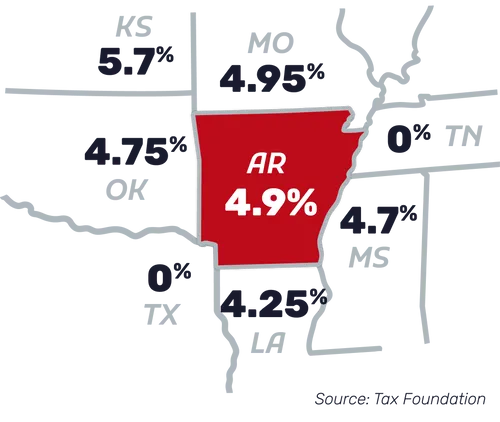
Not only does Tennessee not have a state income tax, but working-class Tennesseans are able to get an occupational license to work nearly two-thirds more quickly than if they lived in Arkansas. 7-8
A variety of factors are at play, but the bottom line is simple: Overregulation and artificial barriers to work that have mounted over time are causing Arkansas’ economy to lag behind its potential — and behind its neighbors.
There is no greater punishment on Arkansas workers than the income tax. Every two weeks, when Arkansans get paid, they are forced to fork over too-large of a share of their earnings to state government.
Imagine if, instead, policymakers gave every Arkansas worker a pay raise by eliminating this work penalty.
Arkansans are Fleeing to More Affordable Climates
Arkansas Gross Domestic Outmigration to Selected States, 2019 – 2020
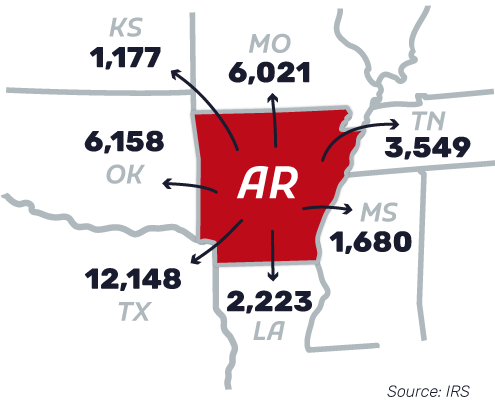
To accelerate the growth of Arkansas’ workforce and help Arkansas families increase their take-home pay, policymakers should address two key areas of concern: 1. The cost of work and 2. Barriers to entry into the workforce.
Our Homegrown Solutions:
Reduce the Cost of Work & Accelerate Entry Into the Workforce
In this sluggish economy, policymakers should be singularly-focused on growing paychecks for all Arkansans. All efforts should be anchored on two guiding principles: 1. Hard work should be rewarded, not punished and 2. Work should be accessible for all Arkansans.
“There’s is no greater punishment on Arkansas workers than the income tax.”

GUIDING PRINCIPLES STATEMENT (GPS):
Hard Work Should Be Rewarded & Work Should Be Accessible for All
Homegrown Ideas for real change
- Phase out the state income tax, which punishes work
- Eliminate the used car sales tax, which increases the cost of Arkansans going to work
- Scrap fees for workers in in-demand industries, which serve as barriers to entry
- Eliminate fees on vocational schools, which raise the cost of vocational education for the next generation of Arkansas workers
- Institute provisional licensure for workers to bypass red tape that keeps Arkansans out of the workforce
- Reduce the maximum length of unemployment benefits to help unemployed workers get back on their feet more quickly
- Enhance work search requirements for unemployment benefits to help break the cycle of government dependency
- Expand broadband access to attract remote workers to Arkansas and open new work opportunities for those already here
- Remove artificial barriers for non-violent offenders who want to work after they serve their sentence, and, if they do not, will fall back into lives of crime or dependency
Pathway #2
PREPARING THE NEXT
GENERATION FOR THE WORKFORCE
To compete in the 21st century, Arkansas needs more skilled workers. Unfortunately, despite their best intentions, Arkansas schools are largely failing to adequately prepare the next generation for the new economy. Many of the problems inherent in the education system are the result of outdated rules and restrictions that prioritize dollars and districts over families and Arkansas’s future.
The Roadblocks:
A One-Size-Fits-All Educational System & Schools That Put the Bureaucracy Before Students
The education system in Arkansas today prioritizes systems over students. Parents are left with little choice about where their kids go to school, as fewer than one-tenth of one percent of education spending is dedicated to school choice.9 Instead, pivotal education decisions are delegated to government bureaucrats and an archaic system, which boxes students into whichever school district they live in, regardless of whether or not it is the best fit for them.
"The education system in Arkansas today prioritizes systems over students."
Unfortunately, the next generation is reaping the consequences of this government command-and-control policy. Arkansas ranks 45th in the nation for college readiness, 43rd in math, and 37th in reading.10 Just 38 percent of Arkansas kids are ready in reading which is a fundamental building block of work-readiness.11
We can do better. We must do better.
Even if government is well-intentioned, it is simply not possible for it to know and understand the unique needs of every Arkansas child. That is why parents, not ZIP codes, should determine where their kids go to school.
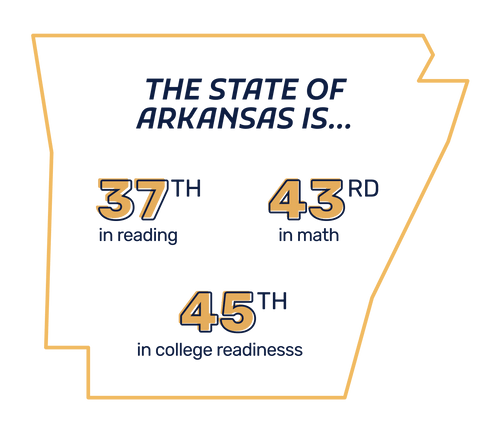
Our Homegrown Solutions:
Put Parents Back in Charge & Students First
Arkansas’s failing education system should be a wake-up call to policymakers that change is urgently needed. Their focus should be on the following guiding principles: 1. Kids deserve opportunity and must be placed ahead of special interests, and 2. Parents should be allowed to choose the path that best fits the needs of their children.
GPS:
PARENTS DESERVE CHOICES & KIDS DESERVE OPPORTUNITY
Homegrown Ideas for real change
- Adopt universal school choice through Education Savings Accounts (ESA) that empower parents to decide which schools best meet the needs of their children
- Eliminate the enrollment cap on inter-district and local students so parents can more easily access public school choice
- Implement fair funding formulas for all school districts to reward choice, innovation, and outcomes
Pathway #3
RESTORING LAW
AND ORDER
Arkansas is in the midst of a massive crime crisis, much of which has been driven by the state’s broken parole system. Over the last decade, violent crime has increased by nearly 40 percent — more than in any neighboring state.12 And it is nearly 70 percent higher in Arkansas than the national average.13
This crime wave threatens the very foundations of opportunity for all Arkansans. Indeed, life is the very foundation of opportunity.
But the crime crisis also threatens the state’s economy: corporations and manufacturers will simply choose to make their homes in neighboring states, where crime levels are a fraction of what they are in Arkansas. Over time, the cost of doing business will skyrocket for existing small businesses which will face higher insurance, security, and hiring costs. And it will become even more difficult to recruit workers into major hubs of the state’s economy (major cities) and from other states.
Truly, Arkansas’s crime crisis threatens not just the people of Arkansas but our very way of life.
"Over the last decade, violent crime has increased by nearly 40 percent."
The Roadblock:
A Broken, Unaccountable Parole System
Arkansas’s parole system lacks transparency and accountability. The system is built upon a foundation of no transparency, no accountability and on perverse incentives that allow career criminals to skirt their sentences.
Compared with most surrounding states, Arkansas is extremely generous in allowing “good time” (good behavior by an inmate) to qualify prisoners for earlier parole.14 Similarly, Arkansas allows a significant portion of a prison sentence to be reduced for other “earned time” programs — even for serious felonies.15 These systems of “good time” and “earned time” desperately need to be reformed.
Violent Crime Per 100,000 Percent Change,
2011-2020, Selected States

Arkansas’s Violent Crime is Nearly 70% Higher than the National Average
Violent Crime Per 100,000, for 2020
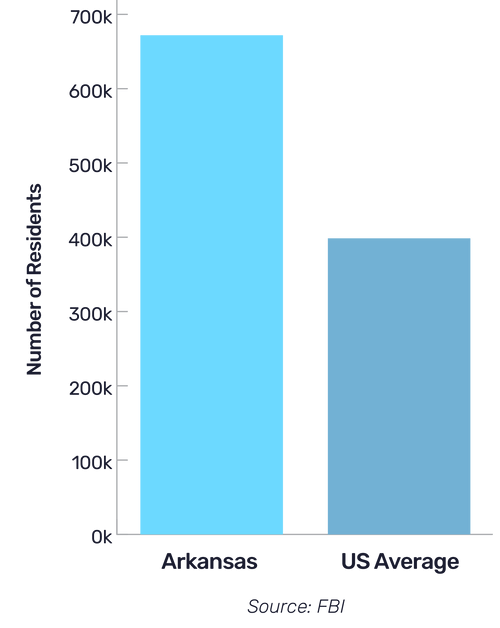
Meanwhile, the antiquated structure of the Arkansas Parole Board invites opportunities for abuse. Unlike in neighboring states such as Louisiana, Arkansas does not publish votes of its parole board members when they decide to move an inmate from prison back onto the streets.16 State parole board members are appointed to seven-year terms with no term limits, which further insulates them from accountability — and Arkansas communities often pay the price.17
To restore public safety, Arkansas policymakers should require that public policy 1. Put victims first and 2. Make law enforcement officers a priority.
GPS:
Victims, Their Families and our Brave Law enforcement officers should always be top priorities
Our Homegrown Solutions:
Accountability For The Parole Board & Justice For Victims
The crime crisis in Arkansas is a direct result of a failure of accountability. Decisions must be guided by public safety and transparency.
To change course, policymakers should be guided by an unwavering commitment to put victims, fam- ilies, and our brave law enforcement officers – not violent criminals – first.
Decisions must be guided by public safety and transparency.

Homegrown Ideas for real change
- Reform the accrual of good time and earned time so that career criminals cannot use loopholes in the system to substantially cut their sentences
- Infuse transparency into the parole board by restricting term length, imposing term limits and publishing parole board decisions to establish real accountability
Pathway #4
PUTTING ARKANSAS
FAMILIES FIRST
Arkansas policymakers should do everything within their power to keep Arkansas kids safe. They should also work to ensure foster care is truly a last resort, not simply a default option, because the outcomes for kids who enter foster care can be devastating: The lack of a stable family unit has been proven time and time again to lead to more crime, more poverty, and more dependency — the opposite of opportunity.
To provide a pathway to opportunity for the next generation, Arkansas policymakers should be fully committed to keeping families together as much as possible and reducing the flow of Arkansas kids into the system.
The Roadblocks:
A Broken Foster Care System
Unfortunately, in Arkansas, the foster care system has become a trap for kids that is increasingly difficult to emerge from. Kids are shuffled from foster home to foster home. Nearly one of every three Arkansas children cycled into the foster care system will be placed in four or more foster care settings, a higher rate than all but one neighboring state.18
"The foster care system has become a trap for kids in Arkansas."
For those for whom adoption is the final outcome, the results are just as bleak: The average Arkansas child will wait years before being adopted, with 13 percent being stuck in the system for more than five years before adoption.19
Those who are not as lucky may find themselves forced to sleep on the floor at the Department of Human Services offices. The state’s foster care system is so overloaded that kids have, on multiple occasions, been forced to sleep in government office buildings.20
Arkansas policymakers should resolve that this never happen again. Arkansas children deserve much, much better.
Together, Arkansas must work to 1. Preserve family integrity as much as possible and 2. Increase the number of quality foster families.
GPS:
Family Integrity Should be prioritized & Foster Care should be last resort

Our Homegrown Solutions:
Protect Arkansas Kids & Preserve Families
Arkansas’s foster care system is at a breaking point, providing little hope for far too many kids. Putting a child into foster care and separating them from their family is inherently traumatic. Arkansas’s approach to foster care policy must be modernized to reflect this reality.
Arkansas kids are stuck in the foster system
Foster care rate per thousand residents

Kids who are in danger absolutely should be protected with no exceptions. But policymakers should update current state policies to ensure family preservation is also prioritized and families are not torn apart simply due to poverty.
Caseworkers and judges should be required to consider family preservation more closely and forced to answer the question, “Does removing a child from their home cause more trauma than leaving them?” Removing them will definitely introduce some level of trauma and set a child down a very difficult path, away from opportunity and toward poverty. The question then becomes, “Must they absolutely be removed?” Foster care should be seen as a true last resort.
"Caseworkers and judges should be required to consider family preservation more closely."
Homegrown Ideas for real change
- Protect parental rights, including the rights of parents with disabilities, to promote family preservation
- Enhance the definition of “best interest of the child” to keep families together as much as possible
- Improve the licensing process for foster parents to ensure children who have no other place to go have safe, caring places to live
Pathway #5
REBUiLDING THE
SAFETY NET
Arkansas deserves a strong safety net that is sustainable for those who truly need it. Unfortunately, that is far from the reality today. The safety net is strained beyond recognition by working-age adults across the state’s largest welfare programs.
These adults are robbed of opportunity, trapped in failing systems, while Arkansas employers are desperate for workers. Truly, this is a recipe for economic disaster that threatens the state’s ability to grow and create opportunity for all.
The Roadblock:
Lengthy Federal Strings & A Culture of Dependency
Today, 1 in 3 Arkansans are on Medicaid, hundreds of thousands of whom are working-age, able-bodied adults.21 Data from the Department of Human Services has shown that nearly half of these able-bodied adults do not work at all.22 So, while Arkansas employers remain desperate for workers — and the state’s safety net is strained to unprecedented levels — able-bodied adults remain on the sidelines, consuming limited resources that should instead be going to support seniors, individuals with disabilities, and Arkansas kids in poverty.
Arkansas’s Medicaid Spending Explodes by More Than 350% Since 2000
Arkansas’s Medicaid Spending By Year
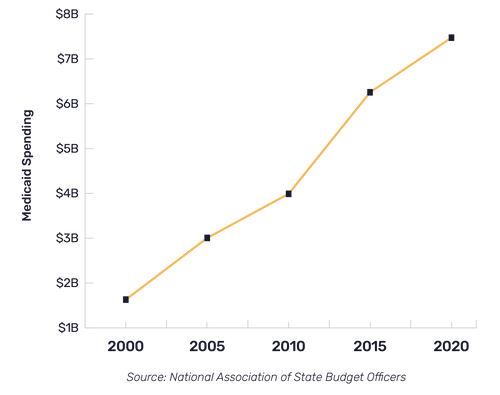
ObamaCare’s Medicaid Expansion Enrollment of Able-Bodied Adults
Medicaid Expansion Enrollment By Year

Equally concerning is the number of individuals on welfare who are ineligible. Since the beginning of the COVID-19 pandemic, Arkansas has chosen to accept extra federal Medicaid funding in exchange for keeping individuals on the program even if they become ineligible — known as “Medicaid handcuffs.” As a result, Arkansas’s Medicaid rolls have increased by more than 200,000 — or more than 20 percent — since the start of the pandemic.23


Even before COVID, more than $1 of every $3 spent on Medicaid in Arkansas was improper, going to waste, fraud, and abuse.24 Today, Arkansas’ welfare system has become an example of fraud by design: the federal government is paying the state government to keep ineligible Arkansans on welfare indefinitely.
To truly unleash opportunity for the next generation, Arkansas policymakers must address the state’s generational welfare crisis by following these two guiding principles: 1. Those who can work should work, and 2. Those who truly need help should get it.
Even before COVID, more than $1 of every $3 spent on Medicaid in Arkansas was improper, going to waste, fraud, and abuse.
GPS:
THOSE WHO CAN WORK SHOULD WORK & THOSE WHO TRULY NEED HELP SHOULD GET IT.
Our Homegrown Solutions:
Put the Truly Needy First
To turn the tide on what is quickly becoming a dependency crisis in the state of Arkansas, state policymakers should pursue reforms that restore the safety net as a true last resort for Arkansans who have nowhere else to turn. This means promoting work over dependency, reforming broken systems to ensure welfare enrollees are encouraged to prioritize work, and rooting out waste, fraud, and abuse.
Homegrown Ideas for real change
- Remove the Medicaid handcuffs to prioritize resources for the truly needy
- Ban food stamp trucks to reduce the cycle of dependency
- Reform time limits for cash welfare to move Arkansans from welfare to work
- Put photo identification on EBT cards to curb fraud and abuse
- Require work search for cash welfare applicants at the time of application to help keep individuals out of the welfare system
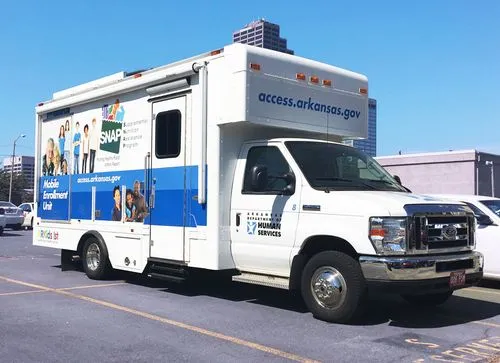

Pathway #6
REDUCING THE STATE
BUREAUCRACY
The biggest impediment to passing savings onto taxpayers — and reducing the cost of work through income tax reform— is a bloated bureaucracy. This sucks up everything in its path. Left unchecked, it will consume more resources and extend more deeply into the lives of Arkansans. And instead of letting Arkansans’ money work for them and for their local small businesses, it will instead be absorbed into the belly of “the beast,” where government will instead decide how it should be best spent.
The Roadblock:
A Bloated State Bureaucracy
Unchecked government growth, particularly during COVID-19, has bloated the size of state government beyond recognition.
Today, for every 100,000 residents, Arkansas has more than 2,500 state employees — an alarmingly higher rate than any neighboring state.24 This vastly outpaces the size of state governments in our region.
Arkansas’s Bloated Bureaucracy
State Government Employees Per 100,000 Residents
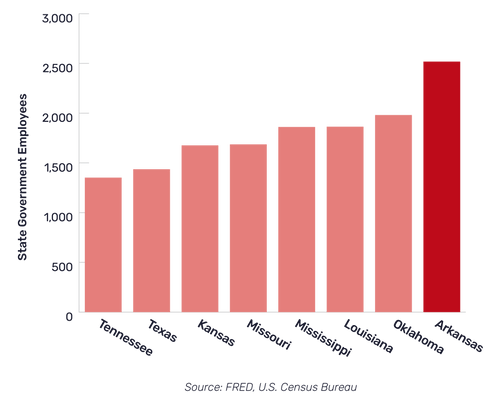
By contrast, Tennessee manages its state government with fewer than 1,400 state employees per 100,000 residents — and without a state income tax.25 In Texas, also with no state income tax, there are fewer than 1,500 state employees per 100,000 residents.26 By all standards, Arkansas’ bureaucracy has grown far too large.
With the bloated state of Arkansas’s government, the following key guiding principles are needed: 1. Government should not grow faster than Arkansans’ paychecks, and 2. Arkansans know how to spend their money better than state government does.
GPS:
GOVERNMENT SHOULD NOT GROW FASTER THAN ARKANSANS’ PAYCHECKS & ARKANSANS KNOW BEST HOW TO SPEND THEIR MONEY
Our Homegrown Solutions:
Put Government on a Diet
Reform is needed to constrain the size of state government so that state government lives within its means, just like Arkansans must do every single day.
Shrinking government is never easy, but it is almost always necessary — especially if policymakers are serious about eliminating the state income tax, as they should be.
It was not always this way. In the mid-2010s, Arkansas implemented a temporary hiring freeze that eliminated nearly 1,500 state positions, saving taxpayers more than $40 million every single year.27
Homegrown Ideas for real change
- Institute a hiring freeze in state government to slow the growth of the size of government and generate savings that can be returned to the people of Arkansas
- Use vacancy savings to reduce the scope of the bureaucracy
- Implement caps on state employee pay to curb excessive salaries that cost taxpayers untold amounts
Endnotes
- In August of 2022, the most recent month available for Medicaid figures, Arkansas’s Medicaid enrollment was 1,125,841. In July of 2021, the most recent month available for population figures, Arkansas’s population was 3,025,891. See, e.g., Arkansas Department of Human Services, “August 2022 Monthly Enrollment and Expenditures Report,” State of Arkansas (2022), https://humanser- vices.arkansas.gov/newsroom/medicaid-arworks-and-other-reports/; and U.S. Census Bureau, “Quick Facts: Arkansas,” U.S. Census Bureau (2022), https://www.census.gov/quickfacts/AR.
- Arkansas Reads, “Arkansas Reads,” Entergy (2022), http://arkansasreads.org/
- In 2020, the rate of violent crime in Arkansas was 671.9 per 100,000 people, compared to 398.5 per 100,000 nationwide. See, e.g., Crime Data Explorer, “Rate of Violent Crime Offenses by Population,” (2021), https://crime-data-explorer.fr.cloud.gov/pages/explorer/crime/crime-trend.
- In Arkansas, just 43 percent of foster care outcomes result in reunification, below the national average. See, e.g., Sarah Catherine Williams, “State-level Data for Understanding Child Welfare in the United States,” Child Trends (2022), https://www.childtrends.org/publications/state-level-data-for-understanding-child-welfare-in-the-united-states.
- Between 2019 and 2020, just over 60,000 Arkansas left the state, or 164 per day. Of these, approximately 60,000, almost 30,000 moved to Texas, Tennessee, Oklahoma, Missouri, or Mississippi, which have lower state income tax rates. See, e.g., IRS, “SOI Tax Stats – Migration Data 2019–2020,” Internal Revenue Service (2021), https://www.irs.gov/statistics/soi-tax-stats-migration-data-2019-2020.
- Between 2019 and 2020, Tennessee’s reported state-to-state total migration inflow was 2.89 times greater than Arkansas’s. See, e.g., IRS, “SOI Tax Stats – Migration Data 2019–2020,” Internal Revenue Service (2021), https://www.irs.gov/statistics/soi-tax-stats-migration-data-2019-2020.
- John Waggoner, “9 States That Don’t Have An Income Tax,” AARP (2022), https://www.aarp.org/money/taxes/info-2020/states-without-an-income-tax.html.
- In Tennessee, the average calendar days lost to occupational licensing requirements is just 226, compared to 642 for Arkansas. See, e.g., Carpenter et al, “Licensed to Work,” (2017), https://ij.org/wp-content/uploads/2017/11/License_to_Work_2nd_Edition.pdf.
- Drew Catt, “The States Ranked By Spending On School Choice Programs, 2022 Edition,” EdChoice (2022), https://www.edchoice.org/engage/the-states-ranked-by-spending-on-school-choice-programs-2022-edition/.
- U.S. News, “Pre-K-12 Rankings,” U.S. News and World Report (2022), https://www.usnews.com/news/best-states/rankings/education/prek-12.
- Arkansas Reads, “Arkansas Reads,” Entergy (2022), http://arkansasreads.org/.
- In 2020, the rate of violent crime in Arkansas was 671.9 per 100,000 people, compared to 482.3 per 100,000 in 2011. See, e.g., Crime Data Explorer, “Rate of Violent Crime Offenses by Population,” (2021), https://crime-data-explorer.fr.cloud.gov/pages/explorer/crime/crime-trend.
- Ibid.
- NCSL, “Good Time and Earned Time Policies for People in State Prisons,” National Conference of State Legislatures (2020), https://www.ncsl.org/Portals/1/Documents/cj/Final-Sentence_Credit_50-State_Chart_2020.pdf.
- Ibid.
- Louisiana makes Pardon Board meeting minutes and agendas publicly available online, unlike Arkansas. See, e.g., Louisiana Department of Public Safety and Corrections, “Pardon Board Schedules & Dockets,” State of Louisiana (2022), https://doc.louisiana.gov/imprisoned-person-programs-resources/pardons-parole/pardon-schedules-dockets/.
- Arkansas Parole Board Policy Manual,” State of Arkansas (2015), https://doc.arkansas.gov/wp-content/uploads/2020/09/ABP_Manual_rev112315.pdf.
- Sarah Catherine Williams, “State-level Data for Understanding Child Welfare in the United States,” Child Trends (2022), https://www.childtrends.org/publications/state-level-data-for-understanding-child-welfare-in-the-united-states.
- Ibid.
- John Lyon, “Children Sleeping In DHS Offices Because Of Foster Care Challenges,” Times Record (2015), https://www.swtimes.com/story/news/2015/12/02/children-sleeping-in-dhs-offices/24367441007/.
- Nic Horton and Victoria Eardley, “ObamaCare’s Not Working: How Medicaid expansion is fostering dependency,” Foundation for Government Accountability (2018), https://thefga.org/paper/obamacares-not-working-how-medicaid-expansion-is-fostering-dependency/.
- In August of 2022, the most recent month available for Medicaid figures, Arkansas’s Medicaid enrollment was 1,125,841. In February of 2022, just before the COVID-19 pandemic Bega, Arkansas’s Medicaid enrollment was just 923,148.
- AFP, “AFP Foundation gets CMS to release state-level Medicaid improper payment data after years of stonewalling,” Americans for Prosperity (2022), https://americansforprosperity.org/afp-foundation-gets-cms-to-release-state-level-medicaid-improper-payment-data-after-years-of-stonewalling/.
- Calculations made using population data from the U.S. Census Bureau and state government employment reported by the Federal Reserve Bank of St. Louis. See, e.g., https://humanservices.arkansas.gov/newsroom/medicaid-arworks-and-other-reports/; and U.S. Census Bureau, “Quick Facts,” U.S. Census Bureau (2022), https://www.census.gov/quickfacts/; FRED, “Economic Research,” Federal Reserve Bank of St. Louis (2022), https://fred.stlouisfed.org/.
- Ibid.
- Ibid.
- Office of Governor Asa Hutchinson, “Gov. Hutchinson Issues Statement on Record-Low Unemployment, Reduction in Government Positions,” State of Arkansas (2017), https://governor.arkansas.gov/news-media/press-releases/gov-hutchinson-issues-statement-on-record-low-unemployment-reduction-in-go.
